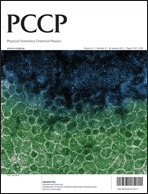Relations between harmonic frequencies of diatomic molecules†
Abstract
The relations between the harmonic frequencies of different molecules are revealed with the aid of the spring constants of atoms in molecules. Using the atomic spring constants in the related molecules, the force constants for a new molecule can be estimated. The simplest scheme to obtain the force constant of a given molecule is similar to a simple chemical reaction formula, such as A2 + B2 → AB, and the corresponding relation between the molecular force constants is kAB−1 = (2kA2)−1 + (2kB2)−1. For a given molecule, one can design numerous schemes to obtain its force constant from the atomic spring constants in other molecules. A high degree of periodical regularity appears in the application of different kinds of schemes to the ground states. The reliable schemes for the ground electronic states can be adopted for the excited states. Over two hundred molecules with


 Please wait while we load your content...
Please wait while we load your content...